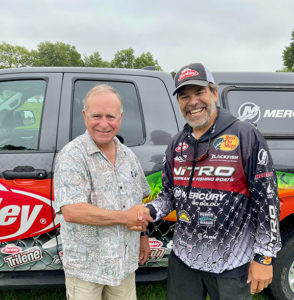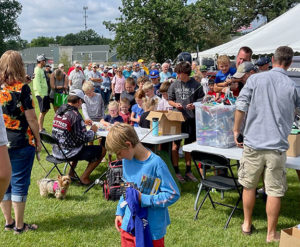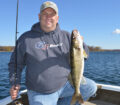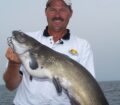By Steve Weisman
I’ve had a little over two months to think back on the seminar presented by pro walleye angler and Fresh Water Hall of Famer Keith Kavajecz at the Okoboji Blue Water Festival on Saturday, August 13. A crowd of over 200 fishing enthusiasts attended the seminar.
Dan Spengler, Senior Project Manager-Bait Development with Berkley/Pure Fishing, who helped bring Kavajecz to the Festival, reflects back on the day. “I had a great time with Keith Kavajecz today! Keith’s seminar was excellent, drawing a large crowd of anglers of all ages! Keith signed Flicker Shads and Flicker Minnows for hundreds of attendees, and we gave out thousands of dollars in Berkley and Spiderwire products to the local community!”
It was pretty obvious that the crowd was totally involved when the expected one hour seminar went into a second hour, and nobody got antsy or got up and left. At 90 minutes, the crowd was still engaged, but because of time limitations, Kavajecz wrapped up his presentation.
Ah, but that wasn’t the end…for the next hour and a half, he took his time hand signing special Berkley Flicker Shads and Berkley Flicker Minnows. Several youngsters even had him sign the back of the T-shirts they were wearing.
Today, most presenters use a screen and a powerpoint presentation to help them explain their topic. Kavajecz, however, chose not to do that. Instead, he used the excitement in his voice, showed the audience the rods, equipment and baits that he uses on his walleye tournament trail. After each segment, he would send that particular piece of equipment around, taking questions from the audience during that time.
As Kavajecz began his presentation, he noted, “Clean water is extremely important for our lakes. At the same time, it has changed how we fish. The hardest thing we fisherman have is finding the fish.” That’s why his boat is equipped with three different type of electronics: down imaging, side imaging and forward facing imaging that helps anglers see what is ahead of them.
With that in mind, Kavajecz asked the crowd. “Why would you ever fish an area where your electronics show no fish?” That’s one of the biggest issues for all anglers. As a tournament pro, Kavajecz can’t afford to do that. He spends more time looking and searching with his electronics to find the fish than he does fish preparing for a tournament.
I find this tip to be really important, especially for those of us fishing our local lakes. Too many times we fish spots and memories instead of locating the fish. They might be in the general area you have been fishing, but maybe moved off the spot. Now what? Sit and wait for the fish? Remember his question: “Why would you ever fish an area where your electronics show no fish?”
Kavajecz also discussed using live bait versus plastics. Plastics have become one of his go-to baits, but he understands why some anglers are hesitant to use plastics. First off, you have to build a trust in the plastic just like you have with live bait. Try the plastics on a day in which the fish are really hitting your live baits. See if they will bite the plastics. If they do, then you can begin to get the feel for the plastics and determine the type of presentation they like. He cautions, however, “It’s a learning experience, and it takes time!”
Throughout the seminar, Kavajecz spent time giving specific tips for using big swim baits for walleyes and crankbaits, noting that the Berkley Flicker Shad and Flicker Minnow continue to be a great bait on many waters! For crankbaits, it’s about getting the crankbait at the right depth and at the right speed. Once again, Kavajecz stresses to “let the fish tell you what bait, what color and what speed is best.”
One technique he mentioned was using a glide bait and shivering. “Right now and into fall,” he noted, “is shivering time of the year!” The bait is called a Shiver Minnow and is often thought of as an ice fishing bait.
The key is to look for deeper areas of structure, like deep rock humps or rock points near drop-offs and to look for the fish on the electronics. His suggestion is to cast the bait out and let it fall to the bottom. Then give a big jerk or snap up and then drop the rod tip so that the bait falls right back to the bottom. This gives the shiver minnow the opportunity to jump and glide off in different directions as it falls back to the bottom. Then reel the slack up and rip the bait up again and repeat the fall! Look for the fish to hit on the glide back down or as Kavajecz says, “once the Shiver Minnow drops to the bottom, walleyes can pin it to the bottom.”
What a morning! So many options and so much knowledge…the best part is that no question was a foolish question…that’s the way we learn…by asking and getting the answers. Excellent job, Keith Kavajecz!

The author (L) shakes hands with Kavajecz, welcoming him to the Okoboji Blue Water Festival.

Kavajecz spent well over an hour signing autographs for both young and adult anglers.


















